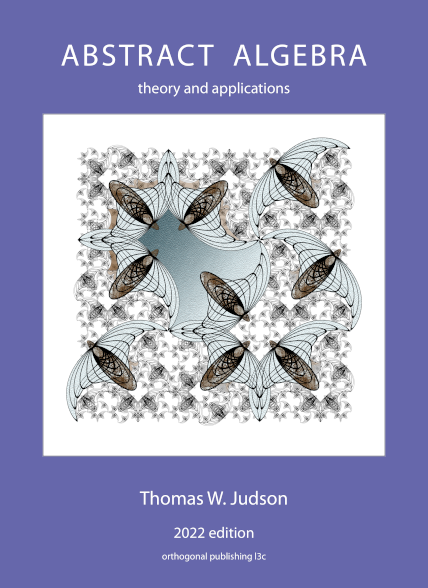Section 11.1 Group Homomorphisms
A homomorphism between groups \((G, \cdot)\) and \((H, \circ)\) is a map \(\phi :G \rightarrow H\) such that
for \(g_1, g_2 \in G\text{.}\) The range of \(\phi\) in \(H\) is called the homomorphic image of \(\phi\text{.}\)
Two groups are related in the strongest possible way if they are isomorphic; however, a weaker relationship may exist between two groups. For example, the symmetric group \(S_n\) and the group \({\mathbb Z}_2\) are related by the fact that \(S_n\) can be divided into even and odd permutations that exhibit a group structure like that \({\mathbb Z}_2\text{,}\) as shown in the following multiplication table.
We use homomorphisms to study relationships such as the one we have just described.
Example 11.1.
Let \(G\) be a group and \(g \in G\text{.}\) Define a map \(\phi : {\mathbb Z} \rightarrow G\) by \(\phi( n ) = g^n\text{.}\) Then \(\phi\) is a group homomorphism, since
This homomorphism maps \({\mathbb Z}\) onto the cyclic subgroup of \(G\) generated by \(g\text{.}\)
Example 11.2.
Let \(G = GL_2( {\mathbb R })\text{.}\) If
is in \(G\text{,}\) then the determinant is nonzero; that is, \(\det(A) = ad - bc \neq 0\text{.}\) Also, for any two elements \(A\) and \(B\) in \(G\text{,}\) \(\det(AB) = \det(A) \det(B)\text{.}\) Using the determinant, we can define a homomorphism \(\phi : GL_2( {\mathbb R }) \rightarrow {\mathbb R}^\ast\) by \(A \mapsto \det(A)\text{.}\)
Example 11.3.
Recall that the circle group \({ \mathbb T}\) consists of all complex numbers \(z\) such that \(|z|=1\text{.}\) We can define a homomorphism \(\phi\) from the additive group of real numbers \({\mathbb R}\) to \({\mathbb T}\) by \(\phi : \theta \mapsto \cos \theta + i \sin \theta\text{.}\) Indeed,
Geometrically, we are simply wrapping the real line around the circle in a group-theoretic fashion.
The following proposition lists some basic properties of group homomorphisms.
Proposition 11.4.
Let \(\phi : G_1 \rightarrow G_2\) be a homomorphism of groups. Then
If \(e\) is the identity of \(G_1\text{,}\) then \(\phi( e)\) is the identity of \(G_2\text{;}\)
For any element \(g \in G_1\text{,}\) \(\phi( g^{-1}) = [\phi( g )]^{- 1}\text{;}\)
If \(H_1\) is a subgroup of \(G_1\text{,}\) then \(\phi( H_1 )\) is a subgroup of \(G_2\text{;}\)
If \(H_2\) is a subgroup of \(G_2\text{,}\) then \(\phi^{-1}(H_2) = \{ g \in G _1: \phi(g) \in H_2 \}\) is a subgroup of \(G_1\text{.}\) Furthermore, if \(H_2\) is normal in \(G_2\text{,}\) then \(\phi^{-1}(H_2)\) is normal in \(G_1\text{.}\)
Proof.
(1) Suppose that \(e\) and \(e'\) are the identities of \(G_1\) and \(G_2\text{,}\) respectively; then
By cancellation, \(\phi(e) = e'\text{.}\)
(2) This statement follows from the fact that
(3) The set \(\phi(H_1)\) is nonempty since the identity of \(G_2\) is in \(\phi(H_1)\text{.}\) Suppose that \(H_1\) is a subgroup of \(G_1\) and let \(x\) and \(y\) be in \(\phi(H_1)\text{.}\) There exist elements \(a, b \in H_1\) such that \(\phi(a) = x\) and \(\phi(b)=y\text{.}\) Since
\(\phi(H_1)\) is a subgroup of \(G_2\) by Proposition 3.31.
(4) Let \(H_2\) be a subgroup of \(G_2\) and define \(H_1\) to be \(\phi^{-1}(H_2)\text{;}\) that is, \(H_1\) is the set of all \(g \in G_1\) such that \(\phi(g) \in H_2\text{.}\) The identity is in \(H_1\) since \(\phi(e) = e'\text{.}\) If \(a\) and \(b\) are in \(H_1\text{,}\) then \(\phi(ab^{-1}) = \phi(a)[ \phi(b) ]^{-1}\) is in \(H_2\) since \(H_2\) is a subgroup of \(G_2\text{.}\) Therefore, \(ab^{-1} \in H_1\) and \(H_1\) is a subgroup of \(G_1\text{.}\) If \(H_2\) is normal in \(G_2\text{,}\) we must show that \(g^{-1} h g \in H_1\) for \(h \in H_1\) and \(g \in G_1\text{.}\) But
since \(H_2\) is a normal subgroup of \(G_2\text{.}\) Therefore, \(g^{-1}hg \in H_1\text{.}\)
Let \(\phi : G \rightarrow H\) be a group homomorphism and suppose that \(e\) is the identity of \(H\text{.}\) By Proposition 11.4, \(\phi^{-1} ( \{ e \} )\) is a subgroup of \(G\text{.}\) This subgroup is called the kernel of \(\phi\) and will be denoted by \(\ker \phi\text{.}\) In fact, this subgroup is a normal subgroup of \(G\) since the trivial subgroup is normal in \(H\text{.}\) We state this result in the following theorem, which says that with every homomorphism of groups we can naturally associate a normal subgroup.
Theorem 11.5.
Let \(\phi : G \rightarrow H\) be a group homomorphism. Then the kernel of \(\phi\) is a normal subgroup of \(G\text{.}\)
Example 11.6.
Let us examine the homomorphism \(\phi : GL_2( {\mathbb R }) \rightarrow {\mathbb R}^\ast\) defined by \(A \mapsto \det( A )\text{.}\) Since \(1\) is the identity of \({\mathbb R}^\ast\text{,}\) the kernel of this homomorphism is all \(2 \times 2\) matrices having determinant one. That is, \(\ker \phi = SL_2( {\mathbb R })\text{.}\)
Example 11.7.
The kernel of the group homomorphism \(\phi : {\mathbb R} \rightarrow {\mathbb C}^\ast\) defined by \(\phi( \theta ) = \cos \theta + i \sin \theta\) is \(\{ 2 \pi n : n \in {\mathbb Z} \}\text{.}\) Notice that \(\ker \phi \cong {\mathbb Z}\text{.}\)
Example 11.8.
Suppose that we wish to determine all possible homomorphisms \(\phi\) from \({\mathbb Z}_7\) to \({\mathbb Z}_{12}\text{.}\) Since the kernel of \(\phi\) must be a subgroup of \({\mathbb Z}_7\text{,}\) there are only two possible kernels, \(\{ 0 \}\) and all of \({\mathbb Z}_7\text{.}\) The image of a subgroup of \({\mathbb Z}_7\) must be a subgroup of \({\mathbb Z}_{12}\text{.}\) Hence, there is no injective homomorphism; otherwise, \({\mathbb Z}_{12}\) would have a subgroup of order \(7\text{,}\) which is impossible. Consequently, the only possible homomorphism from \({\mathbb Z}_7\) to \({\mathbb Z}_{12}\) is the one mapping all elements to zero.
Example 11.9.
Let \(G\) be a group. Suppose that \(g \in G\) and \(\phi\) is the homomorphism from \({\mathbb Z}\) to \(G\) given by \(\phi( n ) = g^n\text{.}\) If the order of \(g\) is infinite, then the kernel of this homomorphism is \(\{ 0 \}\) since \(\phi\) maps \({\mathbb Z}\) onto the cyclic subgroup of \(G\) generated by \(g\text{.}\) However, if the order of \(g\) is finite, say \(n\text{,}\) then the kernel of \(\phi\) is \(n {\mathbb Z}\text{.}\)
